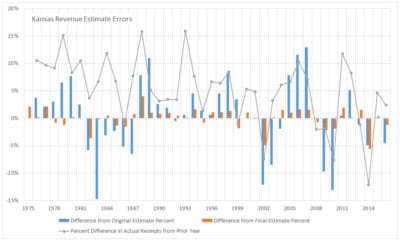Kansas revenue estimates are frequently in the news and have become a political issue. Here’s a look at them over the past decades.
A favorite criticism of liberals and progressives across the nation is that in Kansas, actual revenues to the state’s general fund have fallen short of projections, month after month. Reading most newspaper reports and editorials, one might think that these negative variances are a new phenomenon, and one relished by the Left. As many as a dozen articles on this topic have appeared in the New York Times in the past two years.
The revenue estimates in Kansas are produced by a body known as the Consensus Revenue Estimating Group. It consists of one member each from the Division of the Budget, Department of Revenue, Legislative Research Department, and one consulting economist each from the University of Kansas, Kansas State University, and Wichita State University.
As described: “This group meets each spring and fall. Before December 4th, the group makes its initial estimate for the budget year and revises the estimate for the current year. By April 20th, the fall estimate is reviewed, along with any additional data. A revised estimate is published, which the Legislature may use in adjusting expenditures, if necessary.”1
The estimates are important because the legislature and governor are required to use them when formulating budgets and spending plans. If the estimates are high, meaning that revenue is less than expected, it’s possible that the legislature or (more likely) the governor will need to make spending cuts. (The other alternative is that leftover funds from prior years may be used, if available.)
If, on the other hand, the estimates are too low, meaning that revenue is higher than expected, the state has collected too much tax revenue. In this case, the state should refund the excess to taxpayers. Some states do that, notably Colorado, although residents may vote to let the state keep the excess.
Some states have true rainy day funds, and the excess revenue might be used to build that fund’s balance. In a true rainy day fund, the fund’s balances can be spent only during specific sets of circumstances.
But in Kansas, the excess revenue is simply called the “ending balance” and is available to spend at the legislature’s whim. That’s what happened in fiscal years 2014 and 2015, when the state spent $340 million and $308 million, respectively, of the ending balance rather than cut spending.
What has been the history of the revenue estimates compared to actual revenue? First, know that making these estimates is not easy. Some of the inputs to the process include the inflation rate in future years, interest rates in future years, and the prices of oil and natural gas in the future. If someone knew these values with any certainty, they could earn huge profits by trading in futures markets.
The state makes the revenue estimates available.2 I’ve presented the results since 1975 in a chart at the end of this article. For each year, two numbers are presented. One it the difference from the Original Estimate and actual revenue. The other is the difference from the Adjusted Final Estimate and actual revenue.
We can see that in fiscal years 2014 and 2016, the variance of the estimates is negative, meaning that revenue was lower than the estimates. The magnitude of these variances, however, is not out of line with the magnitude of the variances of other years, either positive or negative.
In fact, the negative variances — revenue shortfalls, in other words — in the periods 2002 to 2003 and 2009 to 2010 were generally much larger in magnitude than those of recent years. This is of interest as Duane Goossen, who was the budget director during these periods, is a prominent critic of the recent revenue shortfalls. Evidently, he has forgotten the difficulty of creating these estimates.
While Goossen along with newspaper reporters and editorialists use the negative revenue estimate variances as a political weapon against the governor and conservatives, it is in the interest of the people of Kansas that revenue estimates be as accurate as possible. In an effort to produce more accurate revenue estimates, Governor Brownback created a commission to study the issue. That group released its report in October.3

—
Notes
- Consensus Revenue Estimating Group. Available at budget.ks.gov/cre.htm. ↩
- Kansas Division of the Budget. State General Fund Receipt Revisions for FY 2016 and FY 2017. May 2, 2016. Available at: budget.ks.gov/files/FY2017/CRE_Long_Memo_April2016.pdf. Also Kansas Legislative Research for 2016 figures. ↩
- Governor’s Consensus Revenue Estimating Working Group. Final Recommendations. Available at budget.ks.gov/files/FY2017/cre_workgroup_report.pdf. ↩
Leave a Reply